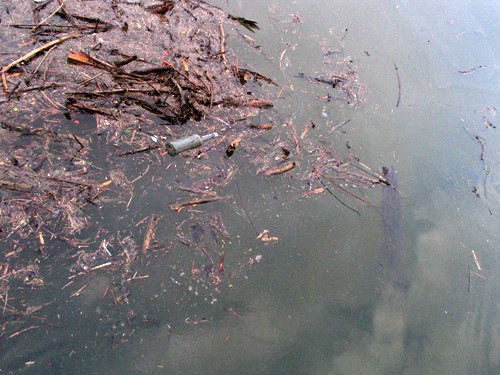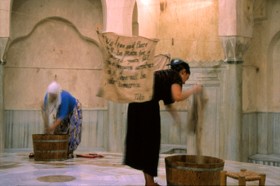
Maja Bajević, Haiku, 2005 © Maja Bajević
The 1st at Moderna: Maja Bajević
Maja Bajević
1.10 2005 – 15.11 2005
Stockholm
Maja Bajević deals with both personal and political elements in her work. In one of her first documented performances, Dressed Up (1999), she cuts up a length of fabric printed with a map of the former Yugoslavia. She then makes up a dress from the pieces of material. The recorded sounds of the artist’s breathing and the noise from the sewing machine are reproduced for the audience that comes in when the dress is finished. Maja Bajević then puts on the dress and leaves the room.
In her video Green, Green Grass of Home (2002) Maja Bajević is seen walking on a lawn in what would seem to be a park. She paces out the dimensions of her old apartment in Sarajevo as best she can remember them while telling us about the different rooms and her memories of her home. The apartment is now occupied. The melancholy mood of the film is balanced by the rather strict tone of her narrative.
Woman at Work – Under Construction (1999) involved a collective performance in Sarajevo. For five days Maja Bajević worked with five women refugees from Bosnia embroidering patterns on the protective netting covering the façade of the National Gallery which was in the process of being repaired after the building had been damaged during the war. The women worked between four in the afternoon and nine in the evening. When darkness fell they lit little lamps that created an intimate and meditative mood – as though they might have been in a private home.
The women taking part normally earn their living by embroidery and they chose the motifs themselves. Besides the fact that their work was highly visible on this central site, Maja Bajević highlighted an everyday, creative activity that does not have access to the museum. And despite the traditional technique and the patterns that were embroidered, the work is also reminiscent of graffiti – of decorating a façade using a popular range of imagery.
Woman at Work II – The Observers (2000) was also a collective performance, presented over the course of five days in connection with a group exhibition in the park of the Château Voltaire where the famous philosopher and author of Candide once lived. As her point of departure Maja Bajević chose a group portrait by the Dutch painter Frans Hals. (Maja Bajević had to search for a long time before she was able to find an historical work of art that portrayed a group of women wearing clothes.) During the performances Maja Bajević and four other Bosnian women sat and embroidered, read and chatted with each other wearing costumes like those in the painting. They acted as models for Alma Suljevic, an artist and friend of Maja Bajević. Also wearing period dress she painted the group.
In the video documentation we can also see the audience which moved about among the women while they were working. As in many of Maja Bajević’s works there are other references which may possibly be inaccessible to those who are not aware of the background. The plural form of the subtitle alludes not just to Dutch painters but also to the troops from the Netherlands who guarded the UN safety zone in Srebrenica – and who failed to act while thousands of Bosnians were being slaughtered. (In his History of the Present, Timothy Garton Ash claims that the UN observers were called “ice-cream men” by the locals on account of their ridiculous uniforms; white shirts, white jerseys, white trousers and white shoes/…/ “cricket umpires or war referees that no one has any respect for”.)
Woman at Work III – Washing Up (2001) takes place in a Haman – a public bathhouse in Istanbul and was a contribution to the Istanbul Biennial. Since only women may visit the bath men were not admitted to the performance which took place when the bath opened for the day. For five days Maja Bajević and a group of women washed textile hangings that displayed slogans and quotations from Tito. But since the water they used was not clean, the repeated washing just made the streamers dirtier and more ragged. After the washing the streamers were hung out to dry. Common to all three “Woman at Work” performances was that they involved a group of Bosnian women which included Maja Bajević herself. Unlike many other performances, it is not the artist and her own body that are central to the works. Yet neither does Maja Bajević stand on the sideline, merely directing the action and considering it from a distance. She joins the women in performing the work with them.
Haiku (2005) represents a new direction for Maja Bajević. In this work there is no narrative, no mis-en-scène. It consists of a slide show using two projectors with one image shown above the other one. The photographs were taken on Maja Bajević’s travels over the course of two years. As with many other artists, travelling is part of her professional life; between exhibitions, to work in studios in other countries and to teach at art colleges. In Haiku, the upper projection shows photographs from various places that the artist has visited. These are not pretty, picture-postcard views but, rather, photographs of mundane, dreary places. At the bottom are shown pictures of the brown waters of the Danube, often close-ups looking straight down into the water without the horizon or the river banks being visible. Each picture is shown for four seconds, a fairly calm and meditative tempo for viewers. Every eighth picture from each of the projectors shows a view of Kosovo. The recurring images from Maja Bajević’s homeland form a resonant foundation for the other pictures; as though they are images that Maja Bajević constantly carries with her on her travels. Thus they form a metaphor of her childhood landscape that has become a part of herself. The pictures from elsewhere also share a mood with those from Kosovo. Perhaps that is why they have assumed a place in her memory.
Curator: Magnus af Petersens
The 1st at Moderna is an exhibition programme for contemporary art. The opening is always on the first day of the month, and the exhibitions are in different venues in or outside the museum.

